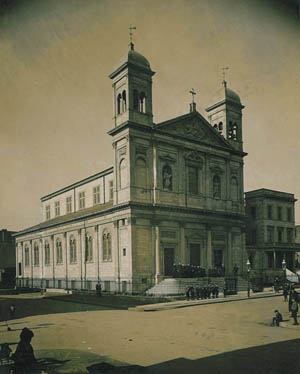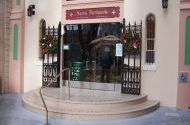A
recent article in
The New York Times prompts me to return to a post begun in September but never completed. When journalist Peter Duffy called in November asking about
presepi in New York City
, I suggested a story about Brooklyn’s Our Lady of Loreto Roman Catholic Church that former Italian-American residents of East New York were
trying to save from destruction by the diocese itself. I had attended a special mass there on September 13
th at the invitation of activist Barbara Anne Lepak. Coincidentally, David Murphy invited me to attend mass the following day at the Santa Febronia Catholic Society’s chapel in Hoboken, New Jersey that is facing its own set of challenges to survive. The consecrated buildings’ respective histories and their associated communities’ responses illustrate how place, and in particular religious space, is remembered, imagined, and reconstituted (or not) in the twentieth-first century.
Barbara emailed me in the summer asking “How do we go about making a Catholic church in Brooklyn a landmark?” Her email continued:
"There is a Catholic church in East New York, Brooklyn, named Our Lady of Loreto. The diocese of Brooklyn has decided to demolish it. This is heartbreaking to all of us who attended this church every Sunday and went to school there. The school building is all ready gone but the church building is so beautiful. It would be a pity to see it taken down."
A (online) Catholic directory of churches published in 1914 states the church was established in 1896 as the diocese’s fourth Italian “national” parish and the structure was completed in 1908 by the architectural firm of Armezzani, Federici (could this be sculptor Gaetano Federici?) and Sons of Paterson, New Jersey. In 1914, there were 8,000 parishioners. The church is not listed in the current AIA Guide to New York City (2000).

I wasn’t able to find more than passing mention of the Italians of East New York in the standard reference literature. (The Times did have a moving article on the subject in December 2004.) Urban planner Walter Thabit documents How East New York Became a Ghetto, noting that two riots in 1966 involving Italian-American, Puerto Rican, and African-American youth drove the remaining white families from the area. The web sites created to save the church contains photographs and personal accounts of the church and the lost community of Italian East New York, constituting a haunting topography of displacement. Approximately thirty people drove from beyond the old neighborhood to attend September mass in honor of Barbara’s late father.

The Times article revealed what the Brooklyn diocese had been denying to former parishioners/activists, that the church is to be demolished to build eighty-eight units of low income housing in eleven four-story buildings.
In Hoboken, I encountered a somewhat different situation. Sicilian immigrants incorporated a lay volunteer association, the Societá di Mutuo Soccorso Santa Febronia Patti e Circondario, in 1922 to honor the third century martyr St. Febronia and the Madonna of Tindari, constructing a freestanding chapel at 557 Fifth Street. The society sponsored processions for the two scared patronesses but the aging and dwindling membership find the task beyond its means.

The chapel had clearly seen better days when I first visited in 2001 to speak on the Black Madonna. The September 2008 mass revealed that the chapel had been spruced up and repaired. Michael Murphy – who’s Sicilian is impeccable – informed me that new, younger people are joining as active members. People are meeting weekly for rosary prayers.
It doesn’t take two days of hallowed reflection to understand the obvious distinctions between these two religious spaces in East New York – a poor, neglected neighborhood of color far from Manhattan skyscrapers – and Hoboken, a predominately white, well-to-do small city.
The most glaring difference is that Our Lady of Loreto is private property, owned by one of the largest and richest corporate entities in the world (and across time). The building is
real estate controlled by the Roman Catholic Church, despite the decades of parishioner volunteer labor and monetary donations that sustained the building and the parish.
The Catholic chapel in Hoboken, on the other hand, is owned by a lay organization not the diocese of Newark. During the great wave of Italian immigration, similar chapels caused great consternation for Father Dominic Marzetti, pastor of Hoboken’s St. Francis Church, who wrote Bishop Winand Michael Wigger on August 9, 1898 expressing his concern about the “contagious fever of building private chapels” among the city’s Italian immigrants (Silvano Tomasi, Piety and Power: The Role of Italian Parishes in the New York Metropolitan Area. 1975). These alternative places of worship were beyond clerical oversight.
It can be urgued that the Brooklyn church is aesthetically more significant that the modest Jersey chapel, a criteria landmark commissions have traditionally depended on. But our understanding of architecture and landscape is not predicated solely on physical structures but how we use and interact with them. Writing about our sense of place, scholar Edward S. Casey noted, "places not only are, they happen." We enact our enviroment. According to Duffy’s article, fewer than twenty people attend weekly mass at Our Lady of Loreto. I will leave it to others to explain why local Catholics – Latinos, Haitian Americans, and others – are not compelled to frequent the church. Whatever the reason, the site’s increasing disuse has transformed it into a dead place, a spent memorial to an Italian-American past. In Hoboken, the private chapel is both sacred space and social club, a place where people gather to pray and socialize in communion on their own terms.















